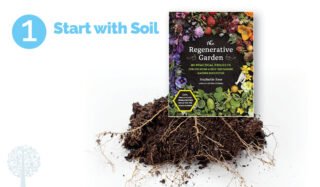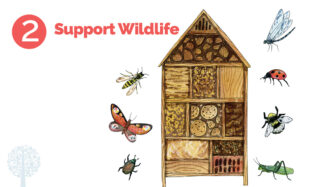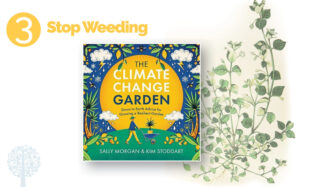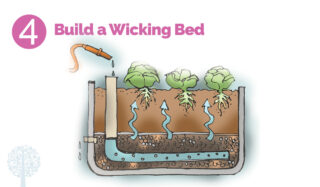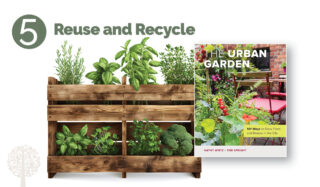
A Guide To Creating A Regenerative, Sustainable Garden Space
Becoming an organic-regenerative gardener is worth every effort, helping you produce healthier crops and connect to Nature. The good news is that implementing sustainable practices in your garden can be as simple or complicated as you’d like; many different projects and efforts contribute meaningfully to the health of your plants and surrounding ecosystems. Looking for ideas? Try these 5 Cool Ways to Create an Eco-Friendly & Sustainable Garden Space.
Start with Soil
One of the most powerful things you can do as a gardener is to treat your dirt like gold. Living soil will help you grow productive gardens while protecting a precious resource. Forget chemical products; compost is your best friend. You can create a composting system that works for you, regardless of your space. Adding organic matter to your garden instantly boosts soil nutrient content, creates air pockets, and helps the earth better retain moisture. Leave no patch of soil uncovered; always mulch your garden space. Covering the earth with a layer of wood chips or leaf mold will prevent water evaporation and add nutrients to the soil as it decomposes. Consider sheet mulching (lasagna gardening) and hugelkultur beds to build nutrient-rich earth while saving water. And avoid digging if you can. Leaving life below the garden surface intact while nourishing it is a top priority. Stepanie Rose’s The Regenerative Garden: 80 Practical Projects for Creating a Self-Sustaining Garden Ecosystem is an excellent resource for gardeners leading the change.
Support Wildlife
We do so much to keep certain critters out of our gardens; don’t forget to put the welcome sign on the gate for many others. Supporting wildlife and making safe spaces for them is essential to thriving ecosystems, and it can be a lot of fun, too. Build some insect hotels or leave stumps or pieces of driftwood in the garden for beneficial bugs to move into so they can help you with pest control. Strategically place birdhouses, baths, or feeders and plant berry bushes to encourage our feathered friends to pop by. Design pollinator islands that include a wide variety of mostly native and only chemical-free plants. Between bee balm and liatris for the bees, coneflowers and milkweed for the butterflies, and foxglove and honeysuckle for the hummingbirds, you’ll end up with a downright gorgeous flower buffet to please the essential pollinators that help your garden grow.
Stop Weeding
We often hear that we need to go back to our roots, and the saying is true for many different reasons. In The Climate Change Garden: Down to Earth Advice for Growing a Resilient Garden, Sally Morgan and Kim Stoddart write about how gardens of the past were rarely decorative and served the functional purpose of growing food for the family. Weeds were encouraged to grow alongside crops for their medicinal properties and ability to attract pollinators and beneficial insects to the garden. Plus, keeping every inch of ground covered was essential for retaining moisture in the summer, nutrients in the winter, and preventing soil erosion. Take a page from the past; let plants like chickweed, lamb’s quarters, and ox-tongue self-seed and grow alongside other plants. They’re beautiful in their own right and create the cottage garden look everyone longs for these days. Fighting Mother Nature is too much work; let her do her thing and reap all the benefits.
Build a Wicking Bed
Wicking beds are an exciting option for water-conscious gardeners. These large, DIY container-like gardens capture water runoff and store it in a reservoir under the bed’s soil so it’s readily available for the plant roots whenever needed. Kiss the garden hose goodbye and say hello to healthy crops with strong roots! You can build wicking beds in the ground or as a raised garden, preferably with recycled materials or cedar posts. You’ll need an impermeable barrier at the bottom to act as the reservoir, drainage pipes for water flow, and gravel to store the water. Place garden fabric on the gravel and fill the bed with soil and plants. You can water the wicking bed manually (about once a week in thesummer) or connect downspouts to the garden and let the rain do the job for you. The Regenerative Garden (Rose) offers excellent step-by-step guides to building wicking beds, keyhole gardens, herb spirals, and more.
Reuse and Recycle
Finding creative ways to use things you already have in the garden is budget-friendly and reduces the amount of waste in landfills (or sitting in your shed). In their book, The Urban Garden: 101 Ways to Grow Food and Beauty in the City, Kathy Jentz and Teri Speight encourage gardeners to find new purposes for items rather than buying new ones. Doing so adds layers of history and depth to the garden because it connects you to previous gardeners and owners or past experiences. Anything that holds soil can be a planter if you create drainage holes. Old bathtubs, sinks, rain boots, and metal trucks can all be used as containers. An old brass bed frame makes a garden trellis and metal chairs can be placed anywhere to create a cozy relaxation and garden observation spot. Grow vertically in repurposed rain gutters and edge garden beds with rocks from your travels, old cinder blocks, or terracotta roof tiles. Finally, Jentz and Speight warn never to throw out broken garden tools. Have a bucket handy to collect broken parts; you can eventually put something together with the pieces. Besides, old rake heads make great hanging racks for garden gloves and small tools!
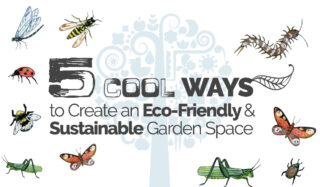

- Catherine Sherriffs
Trending Articles Today
Similar Articles
5 Cool Ways Regenerative Agriculture Works
Regenerative Agriculture is the future, and it's simpler than you might think! Check out our list of 5 cool ways this natural growing method works.

Could Regenerative Agriculture Be the Answer to Climate Change?
We can’t continue farming following conventional practices. Rich Hamilton looks at regenerative agriculture and how it might help mitigate climate change.

A Dirty Kid Is A Happy Kid – Inspiring The Younger Generation To Love Soil
As a follow-up to World Soil Day, Jennifer Cole chats with soil expert Lewis Fausak, author of a children’s book that encourages falling in love with soil.


